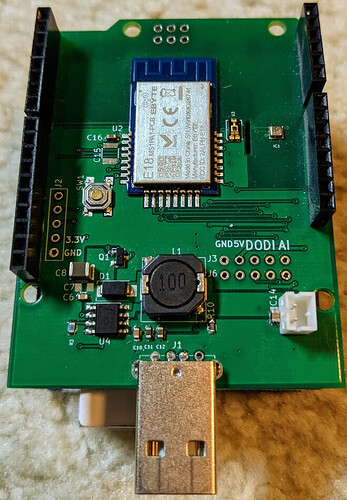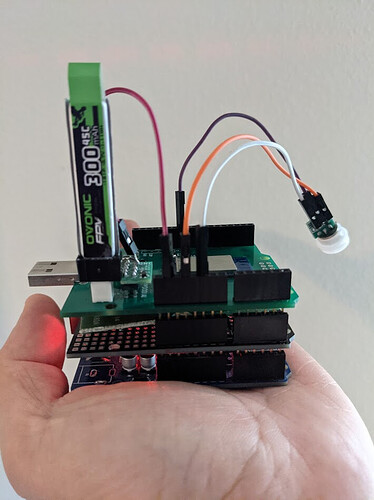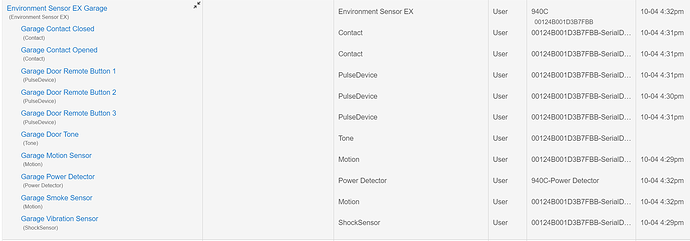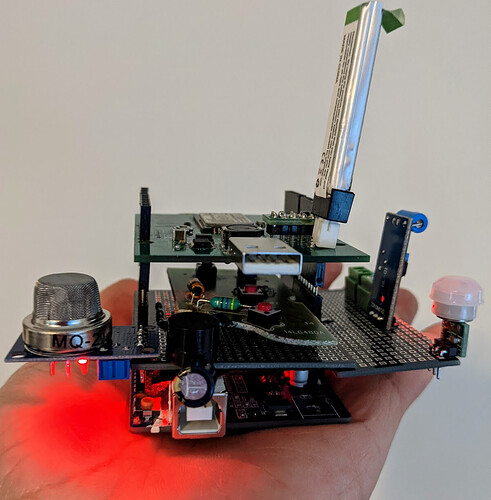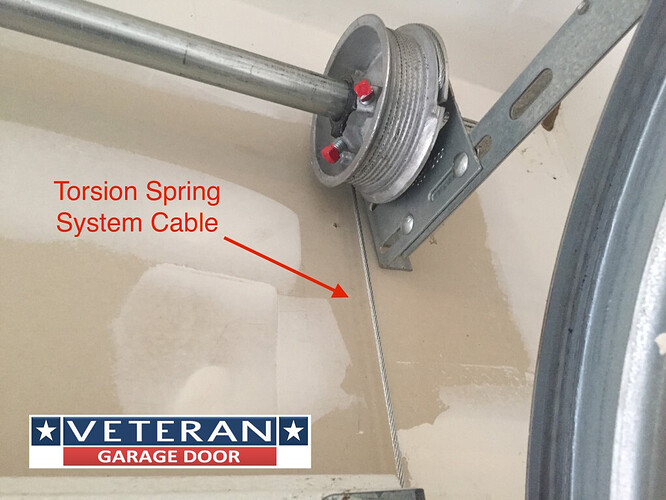It resembles the ISS! 
I just want to update everyone here that over the weekend moved the garage door solution using Arduino to support 3 buttons.
In the past, I have made an Environment Sensor that is in the form of Arduino UNO shield.
I soldered an Garage door remote to Arduino shield prototype board.
The last parts needed is an Arduino UNO. Just FYI, I am using a clone with WAVGAT brand. This looked like Arduino UNO R3. It is not exactly the same. The WAVGAT run on 3.3V (not 5V).
Here is how it look like stacked together.
Here is a short video clicking the button 3.
The Arduino is overkill just to help pressing the button. There are many GPIO ports that is still free to use. I am also planning to add more and more sensor to it. I have a motion sensor connected to it and AC power detection to it.
Thanks
Iman
I just add a few more sensors. I think they will be the final set of device/sensors that I have integrated. I will be installing it this coming weekend in my garage. Here are the final set of sensors. I just add a sets sensor/device to address some safety aspect of the garage door. I added the smoke sensor and a beeper. It is inspired by the work done @manuelangelrivera with his garage door.
All of the above fit in the palm of your hand.
That thing is a monster lol
You need to 3d build a case for it
I have 3d printer. It is a bad one. In combination with my poor mechanical skill, I never really gotten anything worth out of my 3d printer.
My plan for this specific project is to let it install bare for now. I know that the Environment Sensor need to have exposure to the air. The light sensor need a clear enclosure.
Eventually, YES, I would like to have a case. Some of those clear food container case may have to do. I have not find any project enclosure that is clear case. If anyone have suggestion, please let me know. This project need the environment exposure. Some sensors really need air flow.
Just an update... I have installed my garage door controller. While setting up the contact sensors, I have another idea to use it as rotary encoder instead of detecting the just the "fully" open and close position.
I posted the demo on another thread. If you missed the demo, Here it is.
I think I would add a detail on how I did this here. The technique is not new. I uses a couple reed switch with a magnet. I install the magnet on my GD pully like below.
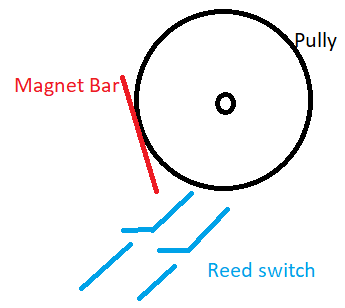 .
.
As the magnet approach the reed switch, I am able to count the position of the garage door. I do need to start from a known position. This is easy to do. I uses fully closed position as 0. The 2 reed switches are needed because I want to know the direction. As the magnet approach the switch, the first switch that is closed first will tell me the direction. The basic principal is as simple as detecting which of the 2 switch closed first and deduce from that the direction of the move. Also, as the event happen, I count up or down depending on the direction. That is pretty much it.
FYI, here is the location of the pully that I use.
I was worried prior to testing this about the accuracy of the encoder. It really depend on the sequence of the contacts closing and opening to get it right. In the end. I am surprised how well it works. It is also have huge tolerance. The installation of the reed switches do not have to be very precise. The magnet does not need to be aligned precisely. My thinking is that the rotation is very slow. Therefore, the encoder does have a lot of flexibility.
I started looking for MYQ replacement. I think with the other stuff that I can fit on the board, I got much more than what MYQ can give.
Brilliant! And I can use this whereas my other ideas have hit major hurdles. Thanks, Iman.
What is the recommended way to remove dust from this? Also, will a lightdim have any adverse effects?
I do not remove dust on mine. It has not giving me any issue. All components on the module is safe to wash. The only sensor that is not washable is BME280. This is the temperature, humidity and pressure sensor. It require air flow therefore it will always exposed to dust. I have seen any degradation on mine so far. Perhaps, if you expose it in unusually high dust area, it could experience issue. Any sensor like this will have issue as they need air flow to do its work. Now, you can use membrane to enclose the sensor. I have nor seen any manufactures that does this for consumer use.
I am not quite understand about this. The light has negligible impact to the longevity of the module. If you imply that dark area is humid, BME280 is one of the best sensor that take care of humidity drift available in the market. I know that many other sensor have manual heater that you have to control to reduce humidity accumulation. BME280 could have handle the automatic heater internally. As developer, we do not need to do anything.
Thanks. It will get a lot of fine feather dust from my amazon and cockatoo. Can I hit it with compressed air from a distance?
The Lightdims I was referring to are dark translucent film stickers meant to darken LEDs. Specifically I want to know if there are any components near the LED that I need to be careful not to cover with such a sticker.
It is a neat approach to the problem.
However, reed switches are notorious for their unreliability. I have worked with tons of them in that past and they fail at the worst times. I don't design with them at all now.
A better choice would be a shaft position encoder. There are all kinds of them. They are simple and VERY reliable. It can be as simple as a coded tape on the shaft of the pulley hub to a digital encoder connected to your pulley shaft.
I have two rollup doors on my horse barn that I will be adding encoders to for the same purpose as you. This way I can tell exactly how far open the doors are at anytime. We leave them slightly ajar periodically for ventilation but close them at night.
Hope this helps.
Everything the modules except the bme280 should be able to handle the blow from compressed air. We are of course not defining the pressure. But, I am assuming that it is typical cleaning blower. The air flow on the BME280 is quite small. I can see that small particle could potentially enter the sensor and accumulate. However, this would take a long time and small particle. I am not sure feather dust from bird is small enough. If you are concern about it, BME280 mentions about using membrane. I have never tried to enclose my sensor with a membrane. I am just concern that it is a costly wrapper that would allow air and humidity pass through. This could get costly real quick.
I would not worry about this at all. The energy consume and translated to light is so small to have any issue.
I will see what mine will last for. I consider other options as well. But, I roll the dice and think that worst come worst the reed switches are maintenance item. We can track the usage and replace them before it failed. My primary goal is to use something simple for simple installation.
The next thing I consider was hall effect sensor. This does not break easily and use the same configuration. I did not go this route as each hall effect sensor need 3 wires (vcc,gnd and signal) vs the simple 2 wires. But, if you are looking for reliability, hall effect sensor as replacement is the way to go.
The shaft position is actually the inspiration for what I did. I study a relative encoder on how it works. I think it is simple enough to handle the signal by the hub. It is a very slow rotation anyway. I do not want to deal on doing the encoder mounting. So, my idea is to adapt the garage door pully as the encoder.
Not sure if you're still active on this project @iharyadi I ordered two sensors last month and am quite excited about them for my project.
I have some questions about temp update. I am using the sensors in a controller for a tissue culture chamber, illuminance updates rapidly, but it seems that temperature only updates maximum once every 30-60s.
Digging through this thread you mention that the bme280 is getting temperature every 0.2s, does this not get pushed to the hubitat immediately like the illuminance?
Is there any way to make it so that the temp value updates more often on the hubitat? The controller I'm building needs to be quite aggressive.
You need to factory reset the sensor. First unplug the sensor from any power. Then, press the button on the back and plug the power back on the sensor. Keep holding the button for 10 to 12 seconds. Finally, release the button and start pairing the sensor.
This will sample the temperature and humidity at higher rate.
In this mode, the sensor may experience self heating. The temperature may be 1 to 2 degree Celsius higher. You can offset this in the DTH.
Awesome I'll give it a go, thanks for the quick reply.
Would be interested in a summary/pictures of that when done.
Welcome to the Hubitat community. It's great to have you.
Happy New Year. 
I have the same situation in my horse barn as well.
I've been looking for a good sensor to use for it. Most of the commercial ones are extremely expensive.
